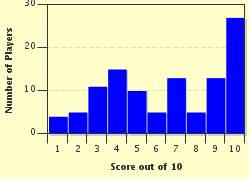Quiz Answer Key and Fun Facts
1. Vitamin A, like most vitamins, is a name used for a selection of structurally similar compounds known as "vitamers". Which of these is not a function of the vitamers of vitamin A?
2. Vitamin B9, also known as folic acid, is important during infancy, pregnancy, and other times of rapid cell division. It is required to transfer CH3 groups from one source to another, which is important in nucleotide synthesis and, therefore, the maintenance of DNA. What name is given to this CH3 group?
3. A vitamin K derivative known as ubiquinone is important as an electron carrier in the mitochondria of our cells. This molecule plays a role in the later stages of respiration and is therefore important to the synthesis of this molecule. Which molecule is this?
4. Vitamin B12 is important in myelin stability (which keeps our nervous system functional). It is used as a cofactor in many enzymatic reactions and is the chemically most complex vitamin. What trace element is found in vitamin B12?
5. Niacin (vitamin B3) is an important cofactor for enzymes known as dehydrogenases, and a lack of this vitamin leads to pellagra. This once widespread disease is characterised by the so-called "Three Ds". Which of these is not one of these Ds?
6. Vitamin E has many functions in the body. One important function of vitamin E is its regulation of protein kinase C, which itself controls the contraction of a specific type of muscle in the body. This muscle type includes that found in the arterioles and the bladder, and its contraction is involuntary. What is it called?
7. Vitamin B7, also known as biotin, is another important cofactor in our bodies. This vitamin assists the enzyme pyruvate carboxylase, which adds a carboxyl group to pyruvate in what is the first step in an important biochemical process. Which process, generally seen as the reverse of glycolysis, is this?
8. Vitamin B6 is metabolised in our bodies to a compound called pyridoxal phosphate. This molecule is a cofactor for aminotransferases - vital enzymes involved in nitrogen management in the body. Where in the body is the main site of transamination?
9. Vitamin D is important in our bodies for the growth and development of bones. It is related to steroids and has the molecular formula C27H44O. What do these characteristics suggest about vitamin D?
10. Vitamin C is perhaps the best known vitamin. Vitamin C is important in several enzymatic reactions in the body and usually functions by donating electrons. With this in mind, which of the following can be used to describe vitamin C?
Source: Author
doublemm
This quiz was reviewed by FunTrivia editor
WesleyCrusher before going online.
Any errors found in FunTrivia content are routinely corrected through our feedback system.

